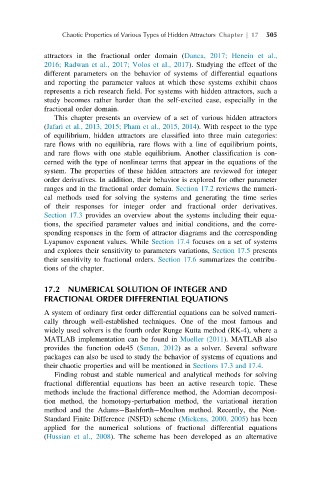Page 518 - Mathematical Techniques of Fractional Order Systems
P. 518
Chaotic Properties of Various Types of Hidden Attractors Chapter | 17 505
attractors in the fractional order domain (Danca, 2017; Henein et al.,
2016;Radwanetal.,2017; Volosetal.,2017). Studying the effect of the
different parameters on the behavior of systems of differential equations
and reporting the parameter values at which these systems exhibit chaos
represents a rich research field. For systems with hidden attractors, such a
study becomes rather harder than the self-excited case, especially in the
fractional order domain.
This chapter presents an overview of a set of various hidden attractors
(Jafari et al., 2013, 2015; Pham et al., 2015, 2014). With respect to the type
of equilibrium, hidden attractors are classified into three main categories:
rare flows with no equilibria, rare flows with a line of equilibrium points,
and rare flows with one stable equilibrium. Another classification is con-
cerned with the type of nonlinear terms that appear in the equations of the
system. The properties of these hidden attractors are reviewed for integer
order derivatives. In addition, their behavior is explored for other parameter
ranges and in the fractional order domain. Section 17.2 reviews the numeri-
cal methods used for solving the systems and generating the time series
of their responses for integer order and fractional order derivatives.
Section 17.3 provides an overview about the systems including their equa-
tions, the specified parameter values and initial conditions, and the corre-
sponding responses in the form of attractor diagrams and the corresponding
Lyapunov exponent values. While Section 17.4 focuses on a set of systems
and explores their sensitivity to parameters variations, Section 17.5 presents
their sensitivity to fractional orders. Section 17.6 summarizes the contribu-
tions of the chapter.
17.2 NUMERICAL SOLUTION OF INTEGER AND
FRACTIONAL ORDER DIFFERENTIAL EQUATIONS
A system of ordinary first order differential equations can be solved numeri-
cally through well-established techniques. One of the most famous and
widely used solvers is the fourth order Runge Kutta method (RK-4), where a
MATLAB implementation can be found in Mueller (2011). MATLAB also
provides the function ode45 (Senan, 2012) as a solver. Several software
packages can also be used to study the behavior of systems of equations and
their chaotic properties and will be mentioned in Sections 17.3 and 17.4.
Finding robust and stable numerical and analytical methods for solving
fractional differential equations has been an active research topic. These
methods include the fractional difference method, the Adomian decomposi-
tion method, the homotopy-perturbation method, the variational iteration
method and the Adams Bashforth Moulton method. Recently, the Non-
Standard Finite Difference (NSFD) scheme (Mickens, 2000, 2005) has been
applied for the numerical solutions of fractional differential equations
(Hussian et al., 2008). The scheme has been developed as an alternative

